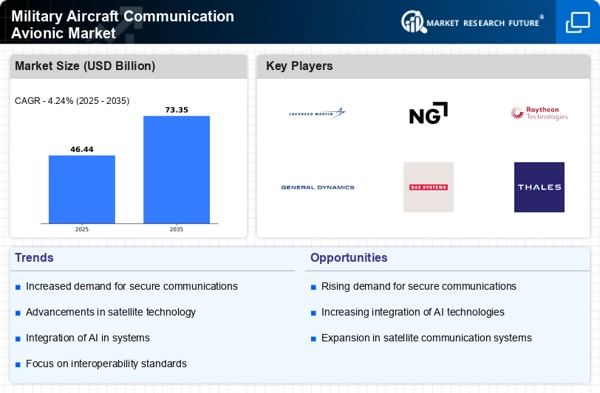Rising Defense Budgets
The Military Aircraft Communication Avionic Market is experiencing a notable surge due to increasing defense budgets across various nations. Governments are prioritizing military modernization, which includes upgrading communication systems in aircraft. For instance, the defense spending in several countries has seen a compound annual growth rate of approximately 3-5% over the past few years. This trend indicates a strong commitment to enhancing military capabilities, thereby driving demand for advanced communication avionics. As nations invest in next-generation aircraft, the need for sophisticated communication systems becomes paramount, further propelling the Military Aircraft Communication Avionic Market.
Technological Advancements
Technological advancements play a crucial role in shaping the Military Aircraft Communication Avionic Market. Innovations such as software-defined radios, satellite communication, and advanced data link systems are transforming how military aircraft communicate. The integration of these technologies enhances operational efficiency and situational awareness. For example, the adoption of software-defined radios is projected to grow significantly, with estimates suggesting a market value exceeding USD 5 billion by 2026. This evolution in technology not only improves communication reliability but also supports interoperability among allied forces, thereby fostering growth in the Military Aircraft Communication Avionic Market.
Increased Focus on Modern Warfare
The Military Aircraft Communication Avionic Market is influenced by the evolving nature of modern warfare, which emphasizes the need for advanced communication systems. As conflicts become more complex, the demand for real-time data exchange and secure communication channels has intensified. Military forces are increasingly relying on integrated communication systems that facilitate coordination among various units. This shift is reflected in the projected growth of the military communication market, which is expected to reach USD 30 billion by 2025. Consequently, the Military Aircraft Communication Avionic Market is poised for expansion as military organizations seek to enhance their operational capabilities.
Emphasis on Cybersecurity Measures
In the context of the Military Aircraft Communication Avionic Market, the emphasis on cybersecurity measures is becoming increasingly critical. As military communication systems become more interconnected, the risk of cyber threats escalates. Consequently, defense organizations are investing in robust cybersecurity solutions to protect sensitive communication channels. The market for military cybersecurity is anticipated to grow significantly, with estimates suggesting a value of USD 20 billion by 2027. This focus on cybersecurity not only safeguards communication systems but also enhances the overall resilience of military operations, thereby driving growth in the Military Aircraft Communication Avionic Market.
Growing Demand for Unmanned Aerial Vehicles (UAVs)
The rise of unmanned aerial vehicles (UAVs) is significantly impacting the Military Aircraft Communication Avionic Market. UAVs require sophisticated communication systems to ensure effective control and data transmission. As military applications for UAVs expand, the demand for reliable communication avionics is expected to increase. Reports indicate that the UAV market is projected to grow at a CAGR of over 15% in the coming years, which will likely drive investments in communication technologies. This trend underscores the importance of advanced communication systems in the Military Aircraft Communication Avionic Market, as they are essential for the successful operation of UAVs.


















Leave a Comment